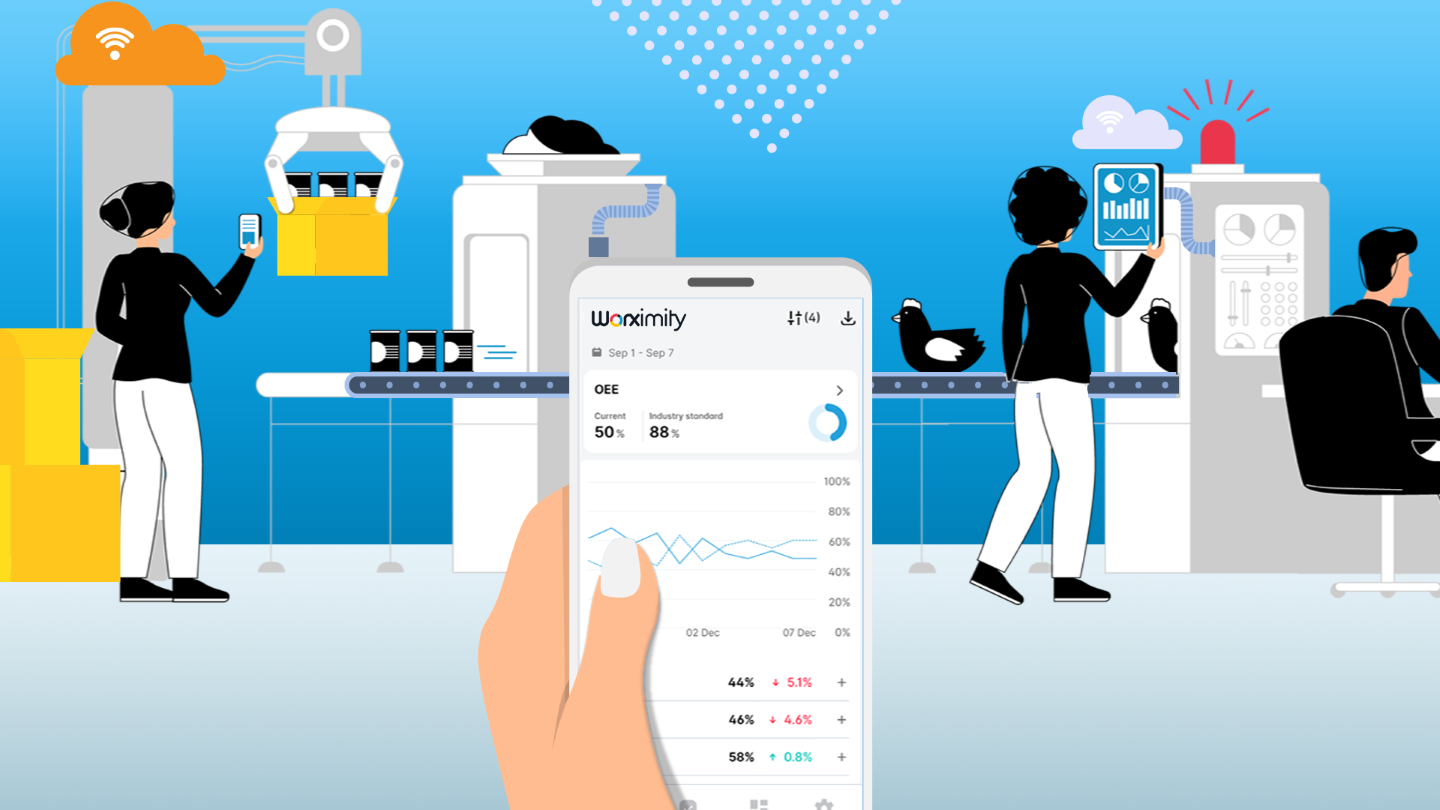Competitive pressures in the food and beverage marketplaces continue to increase, but these challenges can be met with comprehensive efforts to reduce production costs. Nevertheless, limited resources require most companies to find a starting point with the greatest payoff. Any program should capture the maximum benefits in the shortest possible amount of time and at the lowest possible costs. It is best for most processors to start with “easy” cost-reduction items before moving on to more complicated projects.
Utilize Data Collected from Production Monitoring Software
Worximity Technology develops and provides production monitoring software that offers data and measures for identifying high-potential cost reduction areas. Our Smart Factory analytics software gathers real-time processing data directly from equipment and wirelessly sends it to the cloud. Production line metrics and KPIs are then calculated and displayed on monitors (TileBoards) located throughout the factory. All employees then have access to up-to-date performance information and can identify any problems that should be addressed.
Look for Quick Wins Along the Production Line
Companies can reduce production costs along production lines where quick gains are often found. In some cases, operating mistakes can be identified and corrected quickly. Some areas where “low-hanging fruit” might be found include the following:
Lost Production
Measures of downtime amounts and causes can be summarized for a piece of equipment or a process. From this analysis, major reasons for downtime can be identified and further analyzed. Some potential areas to research include frequent or poorly executed changeovers, machine jams, or incorrect materials being used. In all of these cases, corrective measures can likely be taken in the short term.
Waste and Defects
Worximity’s Smart Factory analytics software tracks the number and causes of incorrect or defective products. Often, excess waste can be eliminated, which can quickly reduce production costs. Sources of poor quality that should be examined include improper equipment settings, incorrect raw material, and failure to follow correct procedures.
Unbalanced Production Scheduling (e.g., Short Runs and Frequent Changeovers)
Evaluating cost per piece by production run quantities can demonstrate how short runs or frequent changeovers increase per-unit product costs. By analyzing line costs, product demand, and operating capacity, it is often possible to adjust production schedules to optimize run sizes.
Incorrect or Ignored Procedures
Analyzing process flows and work tasks can uncover non-value-added steps or activities. Unnecessary moves, excessive rearrangements, or unneeded transfers might be streamlined or eliminated. It is also important to evaluate how carefully team members follow predefined process flows and work steps. Close communication with the production team often accelerates the implementation of changes.
Drive Long-Term Cost Savings Using OEE KPIs
Longer-term improvements often yield greater benefits than quick wins, but they require more analysis and time. One important KPI captured by our Smart Factory analytics software is overall equipment effectiveness (OEE). This metric can be used to analyze run speeds, evaluate quality levels, gauge downtime, and develop other operating measures. A program to improve throughput and reduce production costs can be established using data from an OEE analysis. Some important areas include the following:
Downtime
Responding quickly to downtime events is key to correcting any issues and getting the line back up and running. Downtime caused by problems such as equipment failure, material jams, or employee errors can be corrected as soon as it is identified. Once changes are made, plans can be developed to avoid the problems in the future.
Maintenance
Significant savings can often be captured by analyzing maintenance procedures. If a machine is running slow, producing incorrect products, jamming, or frequently breaking down, OEE values for the equipment will reflect lower performance. Analyzing maintenance processes can uncover savings opportunities. Are correct parts being installed? Are procedures being followed? Are staff members adequately trained? An improvement plan to update and change maintenance procedures can correct problems and improve equipment performance.
Quality
Long-term improvements in quality can be achieved by ensuring correctly functioning equipment, eliminating human error, and careful controlling raw material. An analysis of OEE values can highlight problem areas leading to defects and rework. To reduce production costs, proper preventative maintenance procedures must be in place, employees should be properly trained, and raw material line-staging procedures must be followed.
Throughput
Analyzing OEE data can help identify areas constraining throughput. Major issues include slow-running equipment, bottlenecks, and failure to follow procedures. These issues should be identified and corrective actions developed and implemented. Good communication with team members can help identify corrective actions, make the job of implementing changes smoother, and help reduce production costs.
Worximity Technology provides robust solutions to improve shop floor management using advanced digital data capture and analysis. See for yourself the advantages companies gain by partnering with us and our Smart Factory analytics. Download our free, informative Guide to Improving Shop Floor Management with Smart Software and call to discuss how we can help you build a stronger presence in your markets.







